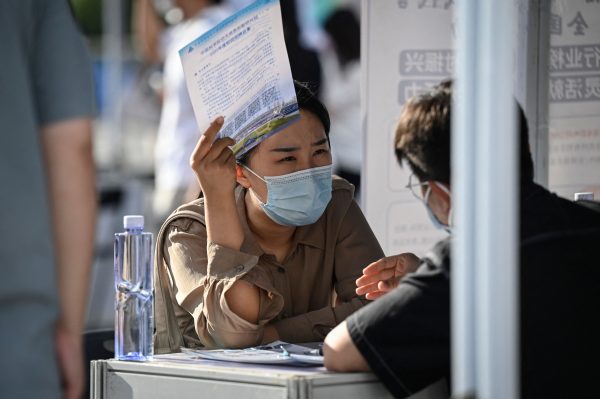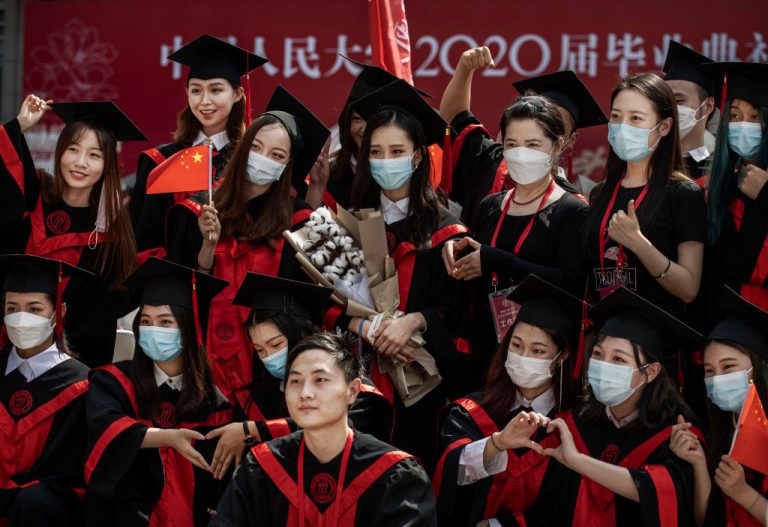Recently, Chinese authorities admitted that the unemployment rate in China for youth aged 16 to 24 exceeded 20 percent. The official numbers indicated that the youth unemployment rate in April 2023, was 20.4 percent, which increased to 20.8 percent in May. However, this startling admission may very well be fabricated and the actual situation in the country may be much, much worse.
According to one mainland Chinese, universities and colleges in the country play a role in manipulating the data, making the unemployment rate look more favorable than it really is. Strip away data manipulation by universities and colleges as well as data tampering by communist authorities and the picture becomes more clear, albeit still murky.
In 1998 communist authorities abolished a system that allocated jobs to college graduates, opting to allow the market to determine a graduates’ employment fate. As a result, employment rates for graduates plummeted. These unfavorable numbers prompted China’s Ministry of Education to implement new legislation in 2004 in a bid to address the issue.
Under this new legislation enrollment at universities and colleges became linked with the employment status of their graduates, meaning if their graduates can’t find jobs it’ll impede future enrollment for the school, thus negatively impacting tuition revenue, among other revenue streams.
Faced with this challenge universities began to shift accountability for dismal results.
Success
You are now signed up for our newsletter
Success
Check your email to complete sign up
“The practice is common, and it’s an open secret,” remarked the man, adding that, “If there is a problem with the employment rate, the Ministry of Education will hold the school accountable. The school will then hold their counselors accountable, and the counselors will hold, guess who accountable? They’ll come after you!”
A common tactic that universities employ in order to hold graduates accountable is to delay issuing students their graduate certificate until they find employment. If they haven’t officially graduated, then they can’t be part of the graduate employment rate, allowing educational institutions to boast about 90 percent graduate employment rates.
Being an “open secret” communist authorities had no choice but to attempt to address the matter.
According to a July 9 article published by the South China Morning Post (SCMP), “Universities in China have been told to verify graduate employment rates amid concerns that some institutions could be submitting fake data to burnish their reputations.”
“Under pressure to maintain high employment rates, some universities have reportedly been pressing their students to lie about job offers,” the SCMP reported.
The SCMP also admitted that universities do indeed withhold graduation certificates from students who fail in securing employment after graduating, saying, “Chinese media also report that some universities have threatened to withhold graduation certificates if students from some graduating classes do not submit proof of employment.”
READ MORE ABOUT CHINA:
- Chinese Govt. Statistics Admit to 20% Youth Unemployment Rate
- Youth Revolt Against China’s Crackdown on E-Bikes, Switch to Unregulated Electric Wheelchairs
- ‘We Have Been Deceived for Too Long’: Chinese Quit the Communist Party

‘Flexibly employed’
Another way that universities and communist authorities manipulate the data is by redefining what the term “employed” actually means, by adding the “flexibly employed” to the data pool.
“Two years ago the central government issued a document…it states clearly that Taobao store owners, self-media, and e-sports workers are all included in the employment statistics,” the mainlander said, adding that, “It means if you have accidentally live-streamed your social media account like Douyin and people tip you a dime, sorry, you are counted as a self-media worker … if one day you have nothing to do and decide to set up a street stall, sorry, you are considered self-employed … [and] if you happen to participate in a game, sorry, you are considered an esports operator.”
According to data released by China’s National Bureau of Statistics, by the end of 2021, the number of Chinese considered to be “flexibly employed” was as high as 200 million people.
These figures include people who do not work traditional full-time jobs from stable employers, instead it includes people who work part-time, at freelance work, are self-employed, like food delivery workers, or work for labor agencies.
Mainland media has attempted to spin these circumstances to make them appear less detrimental. Communist party mouthpiece, Guangming Daily, recently published an article with the headline, “Young people prefer flexible employment, no need to overly worry.”
It argued that instead of steady, reliable employment, youth prefer the autonomy that comes with being flexibly employed and that they are no longer obsessed with landing a good job and instead pursue things that are “compatible with their interests and professional skills.”
READ MORE:
- ‘Taking Charge of My Destiny’: Chinese Quit the Communist Party
- Investors Wary of China’s Economy Amid Stagnant Post-Pandemic Recovery and Anticipated Stimulus Measures
- Mongolian Prime Minister’s China Trip Highlights Growing Economic Dependence on Beijing

What is China’s unemployment rate?
Obtaining an accurate picture of China’s actual unemployment rate is near impossible, and some mainland Chinese media have admitted it.
In November, 2022 the SCMP published an article entitled, “How reliable is China’s job data, and who is included in the unemployment rate.”
The article admits that “Observers have long questioned China’s unemployment rate. It is often seen as too low and too stable, and therefore not an accurate snapshot of the job market.”
Analysts point out that China’s employment figures do not fully cover the country’s near 300 million rural migrant workers, one of China’s most vulnerable groups.
“The official figures have underestimated the overall pressure on the labor market,” commented Wang Dan, chief economist at Hang Seng Bank China, in November 2022, adding that, “Under the strict COVID prevention policy, the urban service industry has been hit hard, and a large number of migrant workers have returned home.”
Communist authorities have claimed a dubious unemployment rate of around 5.5 percent for more than four years, with exceptions being in February 2022 when it hit 6.2 percent and April of the same year when it hit around 6.1 percent.
“That it has changed only slightly amid enormous pressure on the economy from the coronavirus pandemic has triggered discussion about its reliability,” the SCMP wrote, adding that, “Officially, a person is considered employed as long as they have undertaken more than one hour of paid work in a week, including those who receive wages while on holiday or some other temporary stoppage.”
This means, one only needs to work four hours per month to be considered employed.
In addition, someone is considered unemployed if they do not have a job, are actively looking for work and can start immediately, meaning those who have given up entirely on a job search are not factored into the unemployment numbers.
These numbers also do not include a number of Chinese workers who are considered “under-employed” meaning they work in jobs below their education level or skill set.
Whatever the actual reality is in China, it is clear that China’s unemployment rate, including that of youth, is much higher than what has been officially communicated and it is something that communist authorities can’t ignore as it is having severe, detrimental effects on the broader economy.














